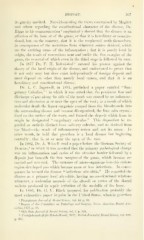Page 509 - My FlipBook
P. 509
HISTORY. 507
its gravity merited. Xotwithstanding the views entertained by ]\Iagit6t
and others regarding the constitutional character of the disease, Dr.
Riggs in his communication ^ emphatically denied that the disease is an
affection of the bone or of the gums, or that it is hereditary or constitu-
tional, but, on the contrary, that it is the roughened teeth themselves,
in consequence of the accretions from whatever source derived, which
are the exciting cause of the InHanimation ; that it is purely local in
origin, the result of concretions near and under the free margins of the
gums, the removal of which even in the third stage is followed by cure.
In 1877 Dr. F. H. Rehwinkel " entered his protest against the
theory of the local origin of the disease, and endeavored to prove that
it not only may but does exist independently of foreign deposit and
must depend on other than merely local causes, and that it is an
hereditary and constitutional disease.
Dr. L. C Ingersoll, in 1881, published a paper entitled ''San-
guinary Calculus," ^ in which it was stated that the persistent flow and
discharge of pus along the side of the tooth was caused by an inflamma-
tion and ulceration at or near the apex of the root ; as a result of which
molecular death the liquor sanguinis escaped from the bloodvessels into
the surrounding tissues and became disorganized, the lime salts crystal-
lized on the surface of the roots, and formed the deposit which from its
origin he designated " sanguinary calculus." This deposition he re-
garded as entirely distinct from salivary calculus, and as derived from
the blood—the result of inflammatory action and not its cause. In
other words, he held that pyorrhea is a local disease but beginning
centrally ; that is, at or near the apex of the root.
In 1882, Dr. A. AVitzell read a paper before the German Society of
Dentists,* in which it was asserted that the primary pathological change
was an inflammation and caries of the alveolar border followed by a
deposit just beneath the free margins of the gums, which became re-
tracted and reverted. The entrance of micro-organisms into this carious
region developed pus Avhich became more or less infectious. In conse-
quence he termed the disease " infectious alveolitis." He regarded the
disease as a primary local alveolitis, having no constitutional relations
whatever, a molecular necrosis of the alveoli or caries of the dental
sockets produced by septic irritation of the medulla of the bone.
In 188G, Dr. G. Y. Black prepared for publication probably the
most exhaustive paper in print in the United States, wherein pyorrhea
* Pennsylvania Journal of Dental Science, vol. iii. p. 99.
^ Report of the Committee on Patholoarv and Surgery, Trans. American Dental Asso-
ciation, 1877, p. 96.
^ Ohio State Journal of Dental Science, vol. i. p. 189.
* Vierteljahresschriflfiir Zaimheilkunde, 1882; British Journal of Dental Science, vol. xxv.
p. 150.


